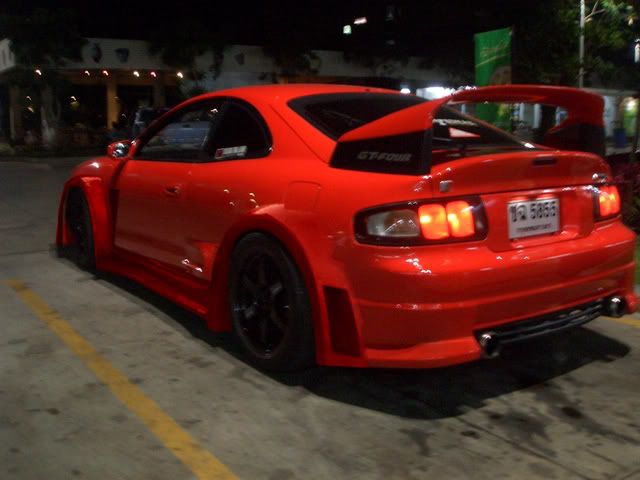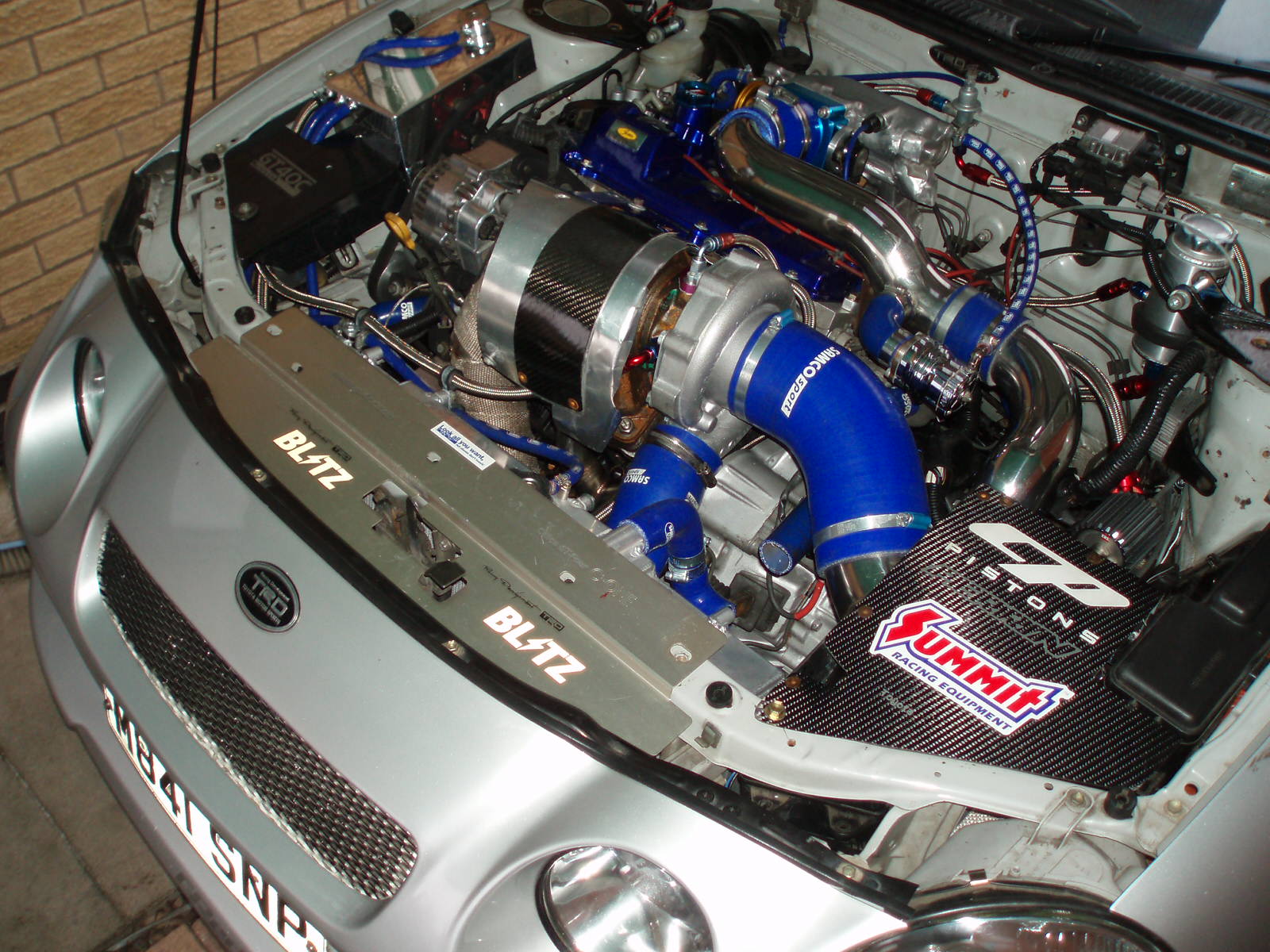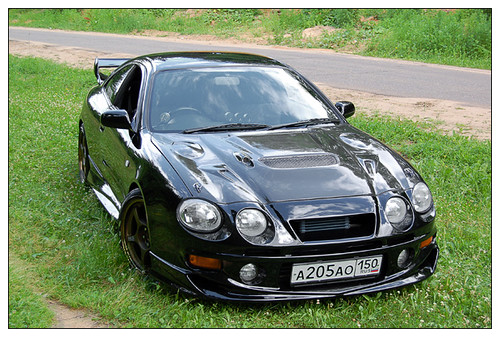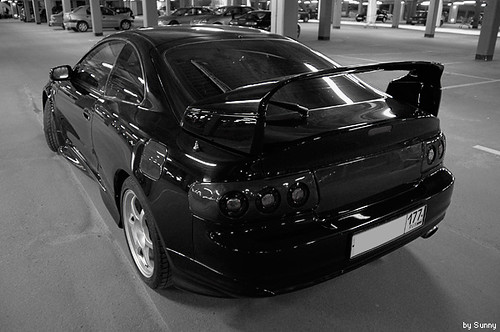This is applicable for all Celicas. The test car used is a 1991 Toyota Celica GT with the 5S-FE engine. Other's may be similar in results. I cannot be held responsible for any damage that occurs to the engine or the car while this procedure is followed. Everything is explained to the best of the author's knowledge. Refer to a Celica manual for more infomation about ignition timing.
Intro: Factory timing for all 90-93 normally aspirated Celicas (ST, GT, and GT-S) is 10? before top dead center (BTDC). This means when the crankshaft angle of the number one cylinder reaches 10?, the spark plug will fire. It fires before it reaches top dead center (TDC) because the flame front takes time to fully combust and push the piston downward.
Retarded timing: If the ignition timing on a car is retarded, then less power is made because the air/fuel mixture doesn't completely combust during the compression/combustion cycle. The flame front completely combusts after the piston has started its power stroke. This results in a loss of power.
Advanced timing: If the ignition timing on a car is advanced (to a certain degree), slightly more power is made because the air/fuel mixture is given time to fully combust and to allow the plug spark to travel. When the air/fuel mixture completes combustion, there is enough power created to slam the piston downward.
Over-advanced timing: If an improper grade of fuel is used combined with an over-advanced timing setting, the effects of detonation can damage the engine. Detonation is when the air/fuel mixture combusts too early or too quickly during the compression stroke. The flame front collides with the upward-stroking piston. Pressure in the cylinder becomes increasingly high. Temperature rises to extremely dangerous levels. This results in engine damage.
Octane Fact: The recommended fuel grade for all the normally aspirated Celicas is 87 octane. Everyone should know that octane is a knock-inhibitor. What octane does is slow down the combustion process. So, it burns slower giving the piston time to compress the mixture and the spark to travel. The power comes from the full combustion of the air/fuel mixture. Higher octane gas + advance timing = more power. I read somewhere about a guy with an N/A Supra who advanced his timing to 25? BTDC and used 120 octane gas. He claims to have made an extra 100 WHP. I find it hard to believe. The power curve for ignition timing is like a parabola: only at one single point will there be a peak power position for both torque and horsepower.
How do I advance my timing?

First, obtain the necessary tools.
- A timing light
- 12 mm socket
- A small piece of wire or paper clip
Make sure your car is at operating temperature. You cannot check the timing correctly if your car has been sitting outside cooling down all day. It must be at operating temperature.
Step 1: Jump terminals
Locate the DIAGNOSIS plug. It's a gray box on the driver’s side by the windshield wiper motor. Open it up, and jump the TE1 and E1 terminals with the wire or paper clip. You'll know when it's jumped when you turn the key to the ON position, and the CHECK ENGINE LIGHT is flashing the "NO TROUBLES" code (1 flash, pause, 1 flash, pause, 1 flash, pause, etc).

Step 2: Hook up the timing light
The timing light has instructions. Read them. Otherwise, listen to me. Red clip goes on positive side of battery; black goes on negative side. That black clippy-thingy goes on the number 1 spark plug wire. Simple.
Step 3: Checking the base timing
Now, you have the terminals jumped and the timing light hooked up. Start the car. The car should sound like it's lugging and the idle should be lower than normal. This means you've jumped it correctly. Locate your underdrive pulley. There are timing notches above the pulley. Point and "shoot" the timing gun at the pulley and notches. You will see what your base timing is currently set at. Make sure you’re viewing the notches dead on and not at an angle. Stand above the engine or to the left on the passenger side to have a dead center straight-on view of the crankshaft pulley and the timing notches.

Step 4: Adjusting
Take the 12mm socket and loosen the holding bolt on the distributor. You can do this while the engine is running as long as you don't pull the distributor out (duh!). Just loosen it enough so that you can move the distributor. Rotate the distributor upward (clockwise) to advance timing; rotate it downward (counter clockwise) to retard timing. Keep using the timing gun to see where you've adjusting the timing to.
Henry’s Corner. I’ve done various degree setting to see what is the best and most efficient degree to set the ignition timing at. I was running with 93 octane for each test.

25?+ BTDC: Only good on a cold winter day. Otherwise, crappy idle.
20? BTDC: A little better than 25? BTDC. There's still some inconsistency in the idling, but it's not serious.
17?-19? BTDC: I haven’t tried it yet. Feel free to tell me the results.
16? BTDC: Pretty good for now. That’s what I have it set at as of December 20, 2000.
12?-15? BTDC: I didn’t have any problems, but I wanted to advance it to 16? BTDC to see how far I could push it.
11? BTDC: Seems just too close to 10? BTDC for any kind of change.
10? BTDC: That’s factory setting. I’m tired of factory. I need change.
7? BTDC: Stupid, Henry; that’s retarding your timing.
I cannot confirm 100% why crappy idle occurs. I said it was due to detonation and the knock sensor was picking up the readings. But there’s a problem: 1990-91 5S-FE’s didn’t have knock sensors… at least that’s what I read. Also, I started to tap on my engine with a hammer, and the timing didn’t retard. Despite that, for some reason when I set the timing to 20?-25?+ BTDC, the timing just retards on it’s own like there was a knock sensor doing its job. I did check my plugs for the effects of detonation and there was no damage at all.
My friend told me that the ECU knows that the base timing is 10? BTDC, and it will try to retard the timing to 10?. Sounds right, but I have evidence that disproves the theory: I'm at 16? BTDC and my car isn't experiencing bad idle.
Step 5: Finishing up
When you've set the timing to where you like it, tighten the 12mm bolt, and turn off the car. Remove the jumper wire. You may start the car again to see what the "adjusted" timing is. Then, remove the timing gun.
Is this mod worth it?
If and only if you're trying to squeeze every bit of power from your car and you're willing to use a higher grade of gas to do it. I can afford to use a higher grade of gas. I know some people can't, so it may not be worth it to them.
How much of a power gain should I expect?
Hopefully, you gain some mad horsepower so you can beat Civic Si's, but I doubt that'll be the case. I read that adding 1? of advance produces 2 horsepower to the wheels. Of course, this is only a guideline, and it varies from car to car.
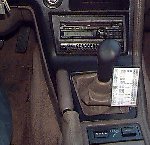 Modify the stock stick. No cost!
Modify the stock stick. No cost!


 The origin of the Celica dates back to 1970, when the first Celica was introduced into the Japanese auto market. Toyota, known for its reliable, basic transportation, felt that its position was strong enough for it to offer its first sporty model. The Japanese economy was strengthening, and with it, the desire to drive something more exciting than the traditional, spartan Japanese automobile. This new attitude by Toyota was reflected first in 1967, with the 2000GT, a swoopy sports car built for Toyota by Yamaha. Featured in a contemporary James Bond film, the 2000GT, with its DOHC inline-6, would later become the inspiration for the Supra (the 2000GT name was also used on later Japanese Celicas and Supras) . As a sidenote, the legendary Datsun 240Z appeared in the same time frame, and may actually have been designed on the same concept as the 2000GT.
The origin of the Celica dates back to 1970, when the first Celica was introduced into the Japanese auto market. Toyota, known for its reliable, basic transportation, felt that its position was strong enough for it to offer its first sporty model. The Japanese economy was strengthening, and with it, the desire to drive something more exciting than the traditional, spartan Japanese automobile. This new attitude by Toyota was reflected first in 1967, with the 2000GT, a swoopy sports car built for Toyota by Yamaha. Featured in a contemporary James Bond film, the 2000GT, with its DOHC inline-6, would later become the inspiration for the Supra (the 2000GT name was also used on later Japanese Celicas and Supras) . As a sidenote, the legendary Datsun 240Z appeared in the same time frame, and may actually have been designed on the same concept as the 2000GT. 
